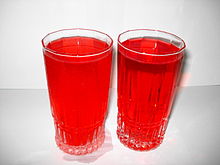Sharbat (drink)

Sharbat or Sherbet (Persian: شربت Sharbat; Azerbaijani: Şərbət; Template:Lang-tr; Marathi: सरबत Sarbat; Hindi: शर्बत; Template:Lang-ur; Punjabi: ਮੈਨੂੰ ਪੀਤਾ Mainū pītā; Template:Lang-bn Shorbot; Template:Lang-hu; Arabic: شربات Sharbāt) is a popular West and South Asian drink that is prepared from fruits or flower petals.[1] It is sweet and served chilled. It can be served in concentrate form and eaten with a spoon or diluted with water to create the drink. Popular sharbats are made of one or more of the following: Rose water, Sandalwood, Bael, Gurhal (Hibiscus), Lemon, Orange, Mango, Pineapple, and Falsa (Grewia asiatica).
Most of the sharbats are very common in Indian, Turkish, Iranian, Arab, Afghan, Pakistani, and Bangladeshi homes.
Etymology

The word Sharbat is from Persian "شربت" "sharbat", and Sherbet is from Turkish "şerbet" "sherbet", both of which in turn come from Arabic شربة "sharba" a drink, from شرب "shariba" to drink. Also called "sorbet", which comes from French "sorbet", from Italian "sorbetto", and in turn from Turkish "şerbet". The word is cognate to syrup in British and American English. Historically it was a cool effervescent or iced fruit soft drink. The meaning, spelling, and pronunciation have fractured between different countries. It is usually spelled "sherbet", but a common corruption changes this to "sherbert".
History
In the 12th century, Persian book of Zakhireye Khwarazmshahi, Gorgani describes different types of Sharbats in Iran, including Ghoore, Anar, Sekanjebin, etc.

It was popularised in the Indian subcontinent by Babur, who sent for frequent loads of ice from the Himalayas to make a cool refreshing drink.[2]
In the gardens of the Ottoman Palace, spices and fruits to be used in sherbet were grown under the control of pharmacists and doctors of the Palace.
In Turkey
The person responsible for preparing and serving şerbet in Turkey is called a sherbetji (Template:Lang-tr).[3] Some serbetci sell sharbat on the street in the traditional way. On their backs they carry a big brass flask with a long nozzle (called an ibrik) and hold glasses in their sash or brass cup-holders. They serve sharbat by bending forward and filling a glass from the nozzle curved over their shoulder.[4] The Şerbetçi family name is derived from this occupation. In rural areas of Eastern Turkey, the groom's family comes to the bride's house after the dowry is agreed upon and brings an ibrik with sharbat for the future bride to drink as a sign of acceptance of the groom.[5]
Give me a sun, I care not how hot, and sherbet, I care not how cool, and my Heaven is as easily made as your Persian's.
— Lord Byron during his visit to Istanbul in 1813[6]
From the Ottoman Empire, the edible form of sharbat also spread into the Balkan area, especially in Romania, where it is known as şerbet.
See also
References
- ^ Molavi, Afshin (2002). Persian Pilgrimages. W. W. Norton & Company. p. 113. ISBN 0-393-05119-6.
{{cite book}}: Cite has empty unknown parameter:|coauthors=(help) - ^ "The Hindu: Keeping cool". Retrieved 3 January 2016.
- ^ The Dervish Lodge. University of California Press. p. 297.
- ^ Pereira, Michael (1968). Istanbul: aspects of a city. Bles. p. 162.
- ^ Korkmaz Erdogdu, Serap (20 April 2012). "Turkish News". Ottoman Fruit Syrups (Şerbet). Retrieved October 30, 2012.
- ^ Wilson, Bee (2011). "Scorching hot day? Grab a gola". The Telegraph.
External links
- Sharbat-e Albalu, Leemoo, Porteghal, Persianmirror.com
- Making Sharbat: Rose Hibiscus, Almond,Khus, IndiaCurry.com
- Sherbat in Arabic, ar.wiktionary.org
- Saudi Aramco World: "World's First Soft Drink"
